Work To Do, Weather Or Not
With severe weather forecast for the weekend, all our plans were scrubbed. We were looking forward to just taking the weekend off to relax and recuperate a bit, but what we got instead was an adventure and a very long day.
It would’ve been a very full weekend, with some cleanup scheduled for the morning and then working the paddling station for BREC Outdoor Adventure’s Great Family Campout. Neither of those were compatible with severe thunderstorms and heavy rain, so it looked like it was going to be a free weekend. Then we got a text from someone who had just paddled Bayou Fountain and found multiple trees down from the weather the previous week. Well, that’s just not acceptable, and hey, it’s just a bit of rain, wind, lightning, possible tornadoes, high water, swift currents,… Okay, let’s just start this by saying, “Please, do not try this at home!”
The water was quite low when we arrived at the launch at Highland Road Park. Eleven of the thirteen steps were dry, and number twelve was only just under the surface. The skies hadn’t opened up, and it was actually a rather pleasant morning. Of course, since nobody but a crazy person would hit the bayou with the radar looking like a Trans-Siberian Orchestra concert, we took advantage of the abundance of parking and used several spaces worth of the gravel lot to park the car and trailer. (Wouldn’t want to get stuck in the mud or tear up the ground at the park. That wouldn’t be polite.)
It started off as a nice, relaxing paddle on nearly still water. With the water so low, we cut off a few more pieces of one of the trees that fell near the park last year, and we could practically stand up going under Rackley Bridge. A bit beyond the bridge (and before the dead-end “tributary” that enters from the left/north side), we came across the first tree. We set the camera on some sometimes-land near the bank and got to work. Then, just a few minutes in, the bottom absolutely dropped out of the clouds. If it looks like night falling in the first scene of the timelapse video, it really was that dark.
The first huge thunderstorm stormed in and then marched right on, leaving a mere drenching rain by the time the tree was fully dealt with. With the tree cleared, and after a quick bailing session, it was on down the bayou with what was now a rapidly building current. All along the banks, water was pouring into the bayou. Every little depression was a full tributary, and even the flat banks had waterfalls. There were even some spots with whitewater, but alas, not quite big enough for me to wish I’d brought a kayak along.
We’ve had some extensive work days before, with as many as five trees down in a week, but this expedition blew away the previous record. The final total was at least ten trees worked, plus various and sundry additional bits. We actually lost count, so it could’ve been eleven or twelve. The timelapse includes several of them, but on several others, the high water and strong current didn’t leave anywhere safe for the camera. (We figured five parts for the video would certainly be enough to get the point, eh?)
As we continued down the bayou, working fallen trees as we came upon them, the current kept building. Then, just a bit above the last mile, the current literally took a hard right and turned off the bayou and into the lowlands. Downstream of that spot, it was still water. And then, as we continued, the current started building again, but this time flowing upstream. The longest scene in the timelapse, scene number four, is actually looking upstream, with the strong current going the “wrong” way. (This is a good example of why flood prevention in south Louisiana isn’t simply a matter of “just dredge all the waterways so they flow faster” — if you make them flow faster when backwater flooding is common, you could easily make things worse.)
Eventually, we’d sliced and diced our way through the fallen trees and paddled (with notable effort) downstream against the strong current all the way to Bayou Manchac. We’d left a few things that were only partially blocking but not fully obstructing the bayou, but we were tired enough to call it good enough for now. I personally decided that I was done for the day and ready to just paddle straight back, but then I added, aloud, “Well, unless a new tree is down, of course.” Not even a mile later, there was suddenly a *crack* *crackity-crackle-CRACK!* and barely 20 yards upstream, a nice green tree performed a graceful swan dive right into the bayou.
In hundreds of trips along the bayou, twice before have we paddled the entire way to Bayou Manchac only to find a freshly fallen tree on our return trip, but never before had we seen one in person. So, as to the question we’ve always had in the back of our minds, “If a tree falls in the bayou, and you are around to hear (and see) it, do you make a sound?” We can now say with confidence that the answer is “Yes” and that the sound is a deep breath, a long sigh, and a “Well, okay then” as we reach for the tools and get to work.
After clearing up the freshly fallen tree, we again headed back upstream. Our intention to take it easy the rest of the way didn’t really work out, as multiple trees that we’d bypassed on the way downstream were rapidly turning into full obstructions thanks to the now-high water and everything the current was bringing with it. We dismantled several of them completely and cleared and broke up jams in several other places, piecing out branches and vines and long logs so things would flow freely as the bayou races along.
Eventually, we made it back to the launch, after what ended up being about an 11-hour work day, with the number of downed trees worked in the double digits for the first time ever. (Thankfully, most of them were at least slightly toward the smaller side by Bayou Fountain standards.) We left behind us a bayou completely clear and ready to paddle (albeit with the water at “Rackley Bridge portage required” level). And as we loaded everything up to go home, the sun actually peeked through the clouds for just a moment as if to say thanks for a job well done.
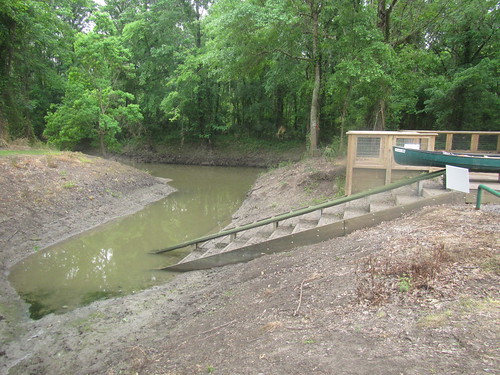

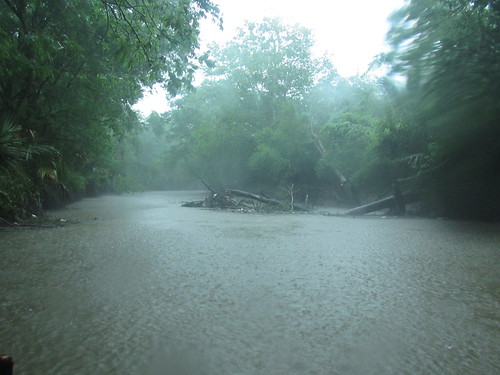
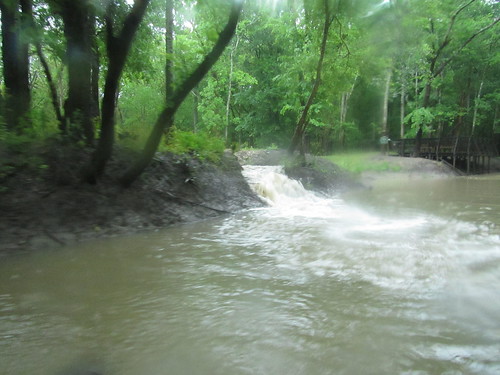

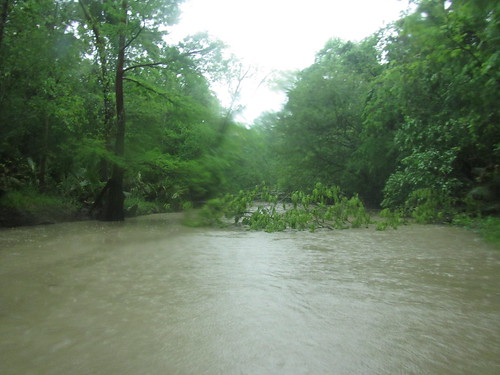

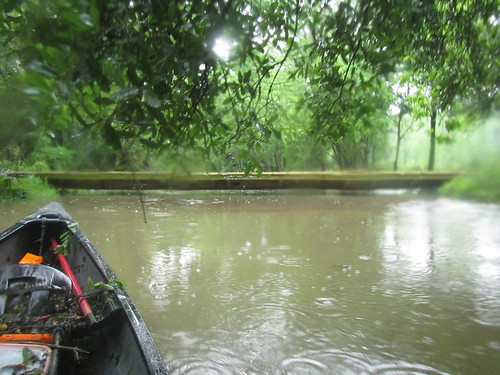
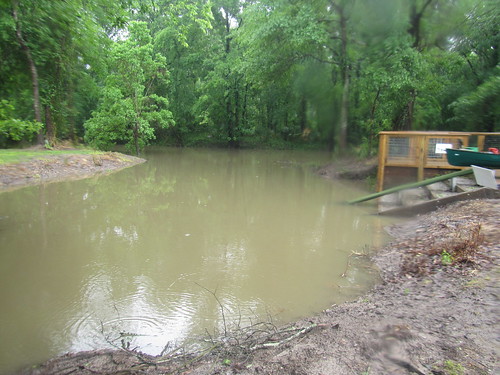

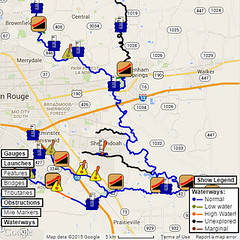
Sounds like the Bayou Fountain is trying to create a new, shorter route to Bayou Manchac.
The whole broad area of swampy bottomland forest around Bayou Fountain acts as a reservoir, really. Whenever there’s a heavy rain, water flows in from both directions and fills the area, and then it gradually empties out. Someday someone should do a survey to see just how much water the area holds — I don’t know the extent of the area that goes underwater, but if it’s not easily in the hundreds of acres, I’d be surprised.